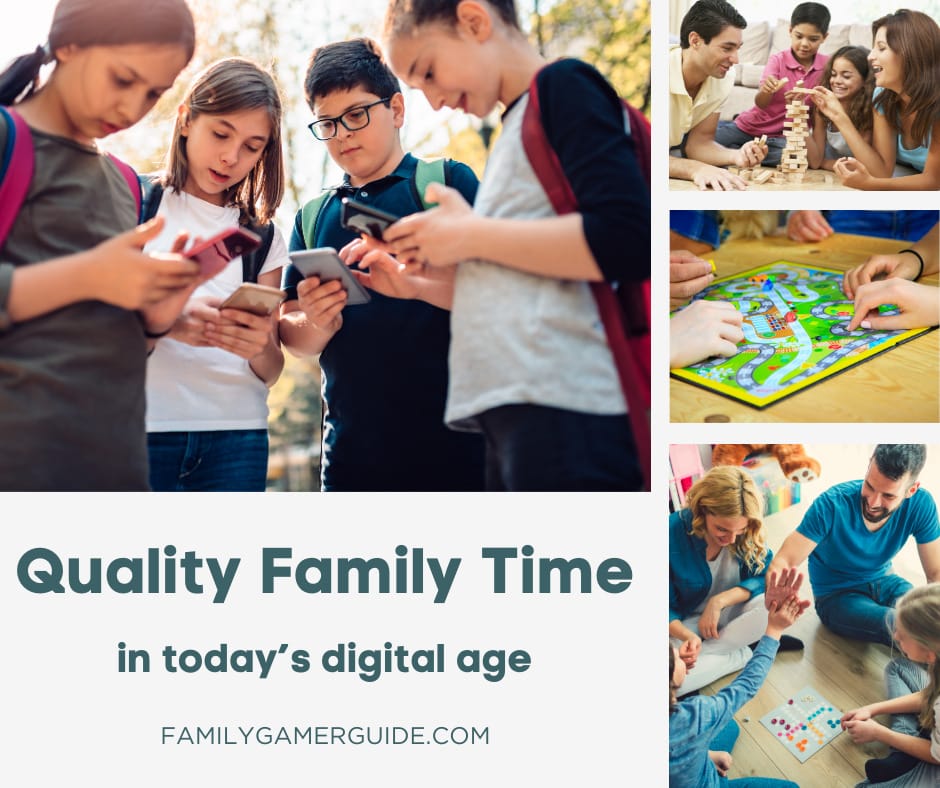Quality family time is crucial for strong relationships and overall well-being, striking a balance with screen time. Benefits include improved communication, reduced stress, and a sense of belonging. In today’s digital age, technology has become integral, altering how we connect and work. However, this reliance on devices often leads to disconnection from our families.
The proven benefits of quality family time include increased happiness, health, and resilience. Shared family activities foster improved communication and reduced stress, creating a safe environment for children to learn and grow.
Recent years have seen drastic changes in the digital landscape and family dynamics, with increased screen time and digital technology. Despite technology’s benefits, finding a balance between screen time and meaningful family interactions is vital. This makes family game night a fantastic way to bring your family together.

Table of Contents
Benefits of Quality Family Time
Spending quality time with your family is an essential part of maintaining healthy relationships and fostering a sense of togetherness. While the digital age has brought about many conveniences, it has also created a divide in family time. However, making time for your family can have numerous benefits that can positively impact your life and the lives of your loved ones.
Strengthening Bonds and Communication
One of the most significant benefits of quality family time is that it strengthens bonds and communication between family members. When you spend time together, you can share experiences, ideas, and feelings that can help you better understand each other. This can lead to improved communication, which is crucial for maintaining healthy relationships.
Whether you’re enjoying a family dinner, playing a board game, or taking a walk together, spending time with your family can help you connect with each other on a deeper level. It can also help you create lasting memories that you can cherish for years to come.
Supporting Child Development and Empathy
Quality family time is also essential for supporting child development and empathy. Children learn from their parents and other family members, and spending time together can help them develop important life skills. This includes language development, problem-solving, and social skills.
When children spend time with their families, they also learn empathy and compassion. They learn how to care for others and understand their emotions. This can help them become more empathetic adults, which can benefit them in all areas of their lives.
In conclusion, quality family time is crucial for maintaining healthy relationships, supporting child development, and fostering a sense of togetherness. By making time for your family, you can strengthen bonds and communication, create lasting memories, and support your children’s growth and development.

The Digital Landscape and Family Dynamics
In today’s digital age, technology has become an integral part of our lives. From smartphones to tablets, we are constantly surrounded by digital media. While these innovations have brought convenience and connectivity, they have also changed the way we interact with our families. In this section, we will explore the influence of technology on family interactions and how to manage screen time and digital media.
Influence of Technology on Family Interactions
Technology has undoubtedly changed the way families interact with each other. With the rise of social media and messaging apps, it’s easier than ever to stay connected with loved ones. However, this constant connectivity can also lead to a sense of detachment and disengagement from real-life interactions. According to a Pew Research Center report, two-thirds of parents in the US say parenting is harder today than it was 20 years ago, with many citing technologies like social media or smartphones as a reason.
It’s important to recognize the impact of technology on family dynamics and take steps to mitigate any negative effects. For example, setting aside designated times for family activities without any digital distractions can help foster stronger connections and improve communication.
Managing Screen Time and Digital Media
Managing screen time and digital media can be a challenge, but it’s important to establish healthy habits early on. The American Academy of Pediatrics recommends that parents limit exposure to most types of screen time before 18 months of age. Parents should also be mindful of their own screen time habits and set a positive example for their children.
Creating a media plan can help establish clear guidelines for screen time and digital media use. This plan should include designated times for screen use, as well as guidelines for appropriate content and device usage. It’s also important to establish consequences for breaking these guidelines, such as loss of device privileges.
In conclusion, technology has undoubtedly changed the way families interact with each other, but it’s important to recognize the impact of technology on family dynamics and take steps to mitigate any negative effects. By managing screen time and digital media use, families can establish healthy habits and foster stronger connections.
Spending Time with Family: Challenges and Solutions in the Digital Age
As the digital age continues to evolve, families are finding it increasingly difficult to spend quality time together. The abundance of online activities and devices can make it challenging to find a balance between technology and family time. However, with a few simple solutions, it is possible to create an environment that fosters quality family time while still embracing the benefits of technology.
Finding Balance with Technology
One of the biggest challenges facing families in the digital age is finding a balance between technology and family time. With so many devices and online activities available, it can be easy to get caught up in the digital world and lose sight of the importance of spending time together as a family.
To find a balance, it is important to set clear boundaries and guidelines for technology use. This might include limiting screen time, setting designated tech-free zones and times, and prioritizing family time over online activities. By setting these boundaries, you can create an environment that promotes quality family time while still allowing for the benefits of technology.
Creating Tech-Free Zones and Times
Another solution for promoting quality family time in the digital age is to create tech-free zones and times. This might include designating certain areas of the house as tech-free zones, such as the dinner table or the bedroom. It might also include setting aside certain times of the day or week as tech-free times, such as before bedtime or during family outings.
By creating these tech-free zones and times, you can encourage family members to disconnect from their devices and focus on spending time together. This can help to promote better communication, strengthen relationships, and improve overall family dynamics.
In conclusion, finding a balance between technology and family time can be challenging in the digital age. However, by setting clear boundaries and guidelines for technology use, and creating tech-free zones and times, it is possible to create an environment that fosters quality family time while still embracing the benefits of technology.
Role of Parents and Guardians
In the digital age, parents and guardians play a critical role in ensuring that their children have quality family time. By setting examples as role models and establishing routines and structures, parents can create an environment that fosters healthy family relationships.
Setting Examples as Role Models
As a parent or guardian, you are the primary role model for your children. Your actions and behaviors can have a significant impact on their attitudes towards technology and family time. Therefore, it is essential to be mindful of how much time you spend on your devices and prioritize spending quality time with your family.
One way to set an example is to establish device-free zones and times during the day. For example, during meal times or family outings, make a conscious effort to put away your devices and engage in meaningful conversations with your family. This will not only help you bond with your family but also teach your children the importance of being present in the moment.
Establishing Routines and Structures
Establishing daily routines and structures can also help create a healthy balance between technology and family time. By setting specific times for activities such as homework, chores, and family outings, you can create a sense of structure and predictability for your children. This can help reduce stress and anxiety and promote a sense of stability in the family.
Creating a family calendar or using a scheduling app can also be helpful in keeping everyone on the same page. This can help ensure that everyone knows what activities are planned for the day or week and can help prevent conflicts or misunderstandings.
In conclusion, as a parent or guardian, you play a critical role in ensuring that your children have quality family time in the digital age. By setting examples as role models and establishing routines and structures, you can create an environment that fosters healthy family relationships.

Resources and Recommendations
In today’s digital age, it’s essential to make sure that your family is spending quality time together. According to the American Academy of Pediatrics (AAP), it’s crucial to balance screen time with other activities to help children develop healthy habits. The AAP recommends that children under 18 months avoid screen-based media except for video chatting. For children aged 18 months to 24 months, parents should choose high-quality programming and watch with their children. For children aged 2 to 5, limit screen time to one hour per day of high-quality programming.
It’s also important to consider the content that your family is consuming. Common Sense Media is an excellent resource for parents who want to ensure that their children are accessing age-appropriate content. They offer reviews and ratings of movies, TV shows, video games, and apps, so you can make informed decisions about what your family watches and plays.
Best Family Games to Play
Here are some of our favorite family games to play.
- Can You Play Catan With 3 Players? Tips to Have Fun & Win!
- Learn to Play Chess: Simple Steps to Mastering the Game
Need a new game? Try one of our favorites.
This cooperative who-dun-it board game means everyone can win together.
Selecting Age-Appropriate Content and Activities to Make Quality Family Time happen
When selecting content and activities for your family, it’s important to keep in mind what is appropriate for your child’s age. Common Sense Media provides age-based recommendations for movies, TV shows, video games, and apps, so you can choose content that is appropriate for your child’s developmental stage.
In addition to selecting age-appropriate content, it’s important to provide your family with a variety of activities that promote quality time together. This can include playing board games, going for walks, cooking together, or simply spending time talking and enjoying each other’s company. By providing a range of activities, you can ensure that your family is spending quality time together and developing healthy habits that will last a lifetime.
In conclusion, it’s essential to prioritize quality family time in today’s digital age. By following the guidance of experts and selecting age-appropriate content and activities, you can ensure that your family is developing healthy habits and spending time together.
Frequently Asked Questions
We’re here to help! Check out our FAQs section below for answers to common questions. If we missed yours, let us know, and we’ll update the article. Contact us through our website, and we’ll respond directly to your question.
How can technology enhance family bonding moments?
Technology can be a great tool for family bonding moments. For example, you can use video chat applications to connect with loved ones who live far away. You can also use technology to play games together, watch movies, or share photos and memories. Just be sure to use technology in moderation and balance it with other activities that promote face-to-face interaction.
What strategies can families adopt to balance digital device use with family interaction?
One strategy is to set boundaries around technology use. For example, you can have designated times when technology is not allowed, such as during meals or family outings. Another strategy is to involve the whole family in activities that don’t involve technology, such as playing board games or going for a walk. By setting limits and finding alternative activities, you can help ensure that technology doesn’t dominate your family time.
In what ways has technology changed the dynamics of family communication?
Technology has made it easier to stay connected with family members, regardless of physical distance. However, it has also changed the way we communicate with each other. Texting and social media can sometimes replace face-to-face conversations, which can lead to misunderstandings and a lack of emotional connection. It’s important to use technology to enhance communication, but not to rely on it exclusively.
What are the benefits of unplugging from technology for family engagement?
Unplugging from technology can help families engage in more meaningful conversations and activities. It can also reduce distractions and promote relaxation, which can help improve overall family well-being. By taking a break from technology, you can focus on connecting with your loved ones and creating lasting memories.
How can parents encourage meaningful conversations in a tech-saturated environment?
One way to encourage meaningful conversations is to ask open-ended questions that stimulate discussion, such as “What was the best part of your day?” or “What are you excited about this week?” Another way is to actively listen to your children and show interest in their lives. By creating a safe space for conversation and being present in the moment, you can help foster deeper connections with your family.
What role does digital literacy play in family relationships today?
Digital literacy is an important skill for families to have in today’s world. It can help parents teach their children how to use technology responsibly and safely. It can also help families stay connected and informed about each other’s lives. By promoting digital literacy, families can use technology in a way that enhances their relationships and promotes healthy communication.
